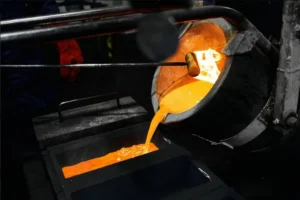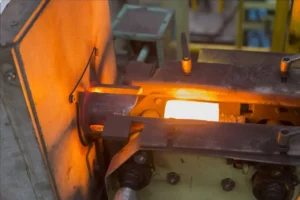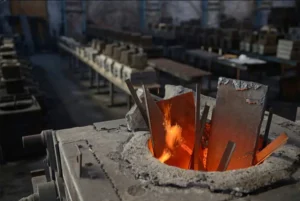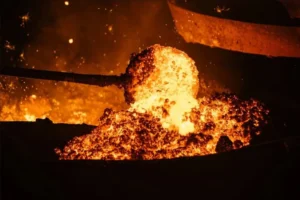
Ang mga kagamitan sa pagtunaw ng induction ay naging isang batong panulok sa industriya ng metalworking at foundry. Ang teknolohiyang ito ay nagbibigay ng isang mahusay na, malinis na, at tumpak na paraan ng pagtunaw ng mga metal para sa iba't ibang mga application. Kung naghahanap ka upang maunawaan ang induction melting equipment at ang papel nito sa pagproseso ng metal, ang post na ito ay magbibigay sa iyo ng isang komprehensibong buod.
Ano ang Induction Melting Equipment?
Induction melting equipment ay isang dalubhasang sistema na ginagamit upang matunaw ang mga metal gamit ang electromagnetic induction. Ang prosesong ito ay nagsasangkot ng isang alternating kasalukuyang dumadaloy sa pamamagitan ng isang likawin, pagbuo ng magnetic field na nagdudulot ng init sa loob ng metal. This heat causes the metal to reach its melting point without direct contact between the metal and a flame or heating element.
The induction melting process is widely used in industries such as metal casting, recycling, and metallurgy due to its precise temperature control and energy efficiency.
Components of Induction Melting Equipment
Induction melting equipment typically consists of several key components that work together to efficiently melt metals:
- Induction pugon: The core component of the system, which contains a copper coil through which electric current passes. This generates the electromagnetic field necessary for heating the metal.
- Power Supply: This supplies the electric current to the induction coil, typically controlled by a transformer to regulate the power input. Ang power supply ay napakahalaga sa pagpapanatili ng pare pareho ang temperatura ng pagtunaw.
- Crucible: Ang sasakyang pandagat na humahawak sa metal na natutunaw. Ang mga crucibles ay kadalasang ginawa mula sa mga materyales tulad ng grapayt o ceramic na maaaring makatiis sa mataas na temperatura nang hindi nasisira.
- Paglamig System: Upang maiwasan ang overheating at mapanatili ang kahusayan ng kagamitan, induction melting equipment ay kinabibilangan ng mga cooling system na nagpapaikot ng tubig o iba pang coolant sa paligid ng coil at power supply.
- Control Panel: Ang operator ay maaaring ayusin ang temperatura, oras na, at mga setting ng kapangyarihan sa pamamagitan ng control panel, na nagpapahintulot para sa tumpak na pamamahala ng proseso ng pagtunaw.
Paano Gumagana ang Induction Melting Equipment?
Induction pagtunaw kagamitan ay gumagana batay sa prinsipyo ng electromagnetic induction. Kapag ang isang electric kasalukuyang dumadaan sa likawin, it generates a magnetic field that induces an electric current in the metal. This induced current heats the metal, causing it to melt.
This process is highly efficient because the heat is generated directly within the metal, as opposed to external heating methods like flame melting, which lose much of the heat to the environment. Bukod pa rito, the control systems allow operators to achieve exact temperatures, which is essential for producing high-quality metals.
Types of Induction Melting Equipment
- Coreless Induction Furnaces: These are the most common type of induction melting equipment. They use a coil that surrounds the crucible, heating the metal through electromagnetic induction.
- Channel Induction Furnaces: In this design, the metal is heated in a channel-shaped coil. This type of furnace is typically used for continuous metal casting.
- Induction Crucible Furnaces: These use a crucible placed inside a coil, providing more efficient heating compared to traditional furnaces.
- High-Frequency Induction Furnaces: These furnaces are designed to operate at higher frequencies, offering quicker and more efficient melting, ideal for smaller batches of metals.
Benefits of Using Induction Melting Equipment
Induction melting equipment offers several advantages over traditional methods of metal melting:
- Energy Efficiency: Induction furnaces are highly energy-efficient because they use electromagnetic fields to generate heat directly in the metal.
- Precision Control: Operators can closely monitor and adjust the melting process, ensuring the metal reaches the exact temperature required.
- Cleaner Process: Induction melting is a clean process, as it doesn’t involve combustion or direct contact with open flames, reducing pollutants and fumes.
- Faster Melting Time: The rapid heating achieved through electromagnetic induction leads to faster melting times compared to other methods.
- Safety: Since induction melting equipment doesn’t require open flames or heating elements, it poses fewer safety risks.
Common Applications of Induction Melting Equipment
Induction melting equipment is used in various industries and applications, including:
- Metal Casting: In the production of castings, induction furnaces provide controlled and clean melting for materials like aluminum, steel, and brass.
- Recycling: Induction furnaces are commonly used in scrap metal recycling to melt down metal waste for reuse.
- Precious Metal Processing: Ang mga high frequency induction furnace ay mainam para sa pagtunaw ng mga mahalagang metal tulad ng ginto, pilak na pilak, at platinum dahil sa kanilang tumpak na kontrol.
- Produksyon ng haluang metal: Ang kagamitan sa pagtunaw ng induction ay ginagamit upang makabuo ng mga haluang metal sa pamamagitan ng pagtunaw at pagsasama ng mga metal sa eksaktong proporsyon.
Pagpili ng Tamang Induction Melting Equipment
Kapag pumipili ng mga kagamitan sa pagtunaw ng induction, Mahalagang isaalang alang ang ilang mga kadahilanan:
- Uri ng Metal: Ang iba't ibang mga metal ay nangangailangan ng iba't ibang mga pamamaraan ng pagtunaw. Isaalang alang ang uri ng metal na plano mong magtrabaho at pumili ng kagamitan nang naaayon.
- Kapasidad: Tiyakin na ang mga kagamitan ay maaaring hawakan ang dami ng metal na balak mong matunaw sa isang naibigay na panahon.
- Pinagmulan ng Enerhiya: Ang mga induction melting furnace ay magagamit na may iba't ibang mga supply ng kuryente, kasama na ang electric, gas, o mga hybrid system. Choose one that best suits your energy preferences and cost considerations.
- Sistema ng Kontrol: Look for equipment with an intuitive control system that allows you to monitor and adjust the melting process efficiently.
Konklusyon
Induction melting equipment plays a vital role in the modern metalworking industry, offering efficient, precise, and cleaner melting compared to traditional methods. By understanding the various types, components, and benefits of induction melting, you can make informed decisions when choosing the right equipment for your metal melting needs. Whether you’re involved in metal casting, recycling, or alloy production, investing in high-quality induction melting equipment can significantly enhance your production processes.







